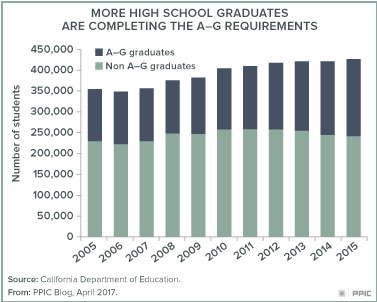Over the past few years more school districts have made college preparatory courses mandatory for high school graduation. These districts have aligned their graduation requirements to the CSU and UC a-g sequence in an effort to make more students college ready. Some of these districts include Los Angeles, Oakland, San Francisco, San Jose, Sonoma Valley, and Vallejo City Unified; the East Side Union High School District in San Jose; and the San Diego Unified, Carlsbad Unified, and Sweetwater Union High School District in San Diego County. Most of these requirements are too new to evaluate, but as more districts make this change, it is important to understand the potential impact. A PPIC report on San Diego Unified found that about 10 percent more students would become eligible to apply to UC and CSU because of the requirement.
The a-g sequence is a set of high school courses required for admission to UC and CSU. The content is rigorous and broad, designed to provide students with a solid foundation of general knowledge. It covers seven different subject areas: (a) history/social science, (b) English, (c) mathematics, (d) laboratory science, (e) foreign language, (f) visual and performing arts, and (g) college-preparatory electives; it includes a total of 15 year-long courses or 30 semesters. These courses are viewed as more rigorous than standard high school courses, as they must meet the criteria developed by the UC’s Board of Admissions and Relations with Schools (It is possible that a non-a-g course is equally rigorous but has simply not undergone a-g approval).
The new a-g graduation requirements have raised concern that many students would be unable to meet them—the reform designed to prepare more students for college might result in lower high school graduation rates. Given this concern, most a-g aligned districts require that students earn a D or higher, which is lower than the UC and CSU requirement of a grade of C or higher.

As it turns out, more students are meeting the a-g requirements with a C or higher. Over the last 10 years there has been an increase of 48% in those meeting the requirements—or 60,000 more high school graduates—with 43% of the class of 2015 doing so.
As more students complete the a-g sequence, the UC and CSU systems receive more applications and admit more students. Between 2011 and 2016, 23% (or 54,383) more Californians applied to UC and CSU, and the systems admitted 20% (or 33,557) more California applicants. However, both systems still limit or deny access to some qualified students. In the 2014‒15 school year, UC redirected 10,688 eligible California students to UC Merced―they had been denied admission to other campuses―but only 195 actually enrolled. The following year, the CSU denied over 17,000 eligible California students, which amounts to almost 55% of denied applicants.
Improvements in college preparation among California’s high school graduates is great news. The challenge is to ensure that our colleges and universities are able to accommodate the increase in demand that comes with it.
Read the report College Readiness in California: A Look at Rigorous High School Course-Taking
Visit the PPIC Higher Education Center


